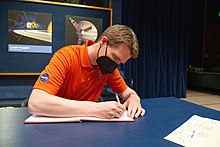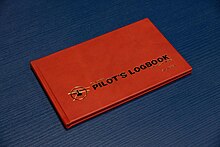Håvard Fjær Grip
Håvard Fjær Grip | |
|---|---|
 Grip, entering Ingenuity flight details in the pilot’s logbook | |
| Nationality | Norwegian |
| Alma mater | Norwegian University of Science and Technology |
| Known for | Pilot of first extraterrestrial helicopter flight |
| Scientific career | |
| Fields | Cybernetics, Robotics |
| Institutions | Jet Propulsion Laboratory, California Institute of Technology, |
| Thesis | Topics in State and Parameter Estimation for Nonlinear and Uncertain Systems (2010) |
Håvard Fjær Grip is a Norwegian cybernetics engineer and robotics technologist. He was the chief pilot of NASA's Jet Propulsion Laboratory's Mars helicopter, Ingenuity, and led the development of its aerodynamics and flight control system. Grip successfully flew Ingenuity's first flight on Mars on April 19, 2021, which made history as the first extraterrestrial helicopter flight.[1][2] As of October 2023[update], he is chief engineer of the Mars Sample Recovery Helicopters, part of the NASA-ESA Mars Sample Return campaign.[3][4]
Career
[edit]From 2001 to 2006, Grip studied for a five-year engineering cybernetics master's degree, and from 2006 to 2010 a PhD at the Norwegian University of Science and Technology. During his studies he was recognized for outstanding academic performance in engineering studies, as well as having the best master's thesis in 2006 in Norway within the field of control and automation.[5][6][7]
Grip's master's thesis was titled Nonlinear Vehicle Velocity Observer with Road-Tire Friction Adaptation. The dissertation focused on real-time estimation of dynamic variables for use in safety systems in cars, such as anti-lock brakes and electronic stability program. Automotive corporation Daimler AG showed interest in Grip's work,[8] and hired him for a contract project at the Daimler Group Research & Advanced Engineering while employed as a scientific researcher at SINTEF ICT from 2007–2008, where he continued researching anti-collision systems for cars.[9]
In 2010, Grip started working as an adjunct assistant professor at the School of Electrical Engineering and Computer Science at Washington State University,[10] where he conducted an independent research project with a grant from the Research Council of Norway.[11]

Since 2013, Grip has worked as a robotics technologist in the Guidance and Control Analysis Group at NASA's Jet Propulsion Laboratory at the California Institute of Technology. He led the Mars Helicopter Guidance, Navigation, and Control team,[12][13] where he designed algorithms and software that helped control and guide the martian helicopter Ingenuity. Grip's role as chief pilot included planning the flight, constructing command sequences, and analyzing the flight data for the helicopter.[14] Other team members that took part in the helicopter project included program executive Dave Lavery, chief engineer Bob Balaram, and project manager MiMi Aung.
The Martian helicopter was launched from Earth along with the rover Perseverance as part of NASA's Mars 2020 mission, a part of NASA's Mars Exploration Program.[15] The rover's mission is to identify martian environments that is capable of supporting life. One of its instruments includes the Radar Imager for Mars' Subsurface Experiment, which is a georadar developed by the Norwegian Defence Research Establishment, led by principal investigator Svein-Erik Hamran, and a team that includes scientists from Norway, Canada and the United States.[16]
On April 19, 2021, at 11:30 UTC, Grip flew Ingenuity for 39.1 seconds, raising the helicopter vertically about 10 feet (3.0 m), rotating in place 96 degrees in a planned maneuver, and landing it successfully.[17][18][19]
Grip's research interests include nonlinear control and observer design, navigation and vehicle state estimation, decentralized control of heterogeneous systems, and structurally based design techniques for stability and robustness of nonlinear systems.[20]
Selected publications
[edit]- H. F. Grip, A. Saberi, and T. A. Johansen, "Observers for interconnected nonlinear and linear systems," Automatica, vol. 48, no. 7, pp. 1339–1346, 2012.
- H. F. Grip, T. Yang, A. Saberi, and A. A. Stoorvogel, "Output synchronization for heterogeneous networks of non-introspective agents," Automatica, vol. 48, no. 10, pp. 2444–2453, 2012.
- H. F. Grip, L. Imsland, T. A. Johansen, J. C. Kalkkuhl, and A. Suissa, "Vehicle sideslip estimation: Design, implementation, and experimental validation," IEEE Control Systems Magazine, vol. 29, no. 5, pp. 36–52, 2009.
References
[edit]- ^ Northon, Karen (2021-04-17). "NASA to Attempt First Controlled Flight on Mars As Soon As Monday". NASA. Retrieved 2021-04-20.
- ^ Slattery, Chad (1 March 2022). "Håvard Fjær Grip: Pilot from Another Planet". AOPA Pilot Magazine. Aircraft Owners and Pilots Association. Retrieved 20 October 2023.
- ^ David, Leonard (13 April 2023). "NASA sets sights on a next-generation Mars helicopter to return Red Planet samples". space.com. Retrieved 20 October 2023.
- ^ McFall-Johnson, Morgan (21 January 2023). "I pilot NASA's first and only Mars helicopter. My job can be like a video game, but not the kind with a joystick". Insider. Retrieved 20 October 2023.
- ^ "Håvard Fjær Grip - Publications". eecs.wsu.edu. Retrieved 2021-04-28.
- ^ "Universitetsavisa". gamle.universitetsavisa.no. Retrieved 2021-04-20.
- ^ "JPL Robotics: People: Håvard Grip". www-robotics.jpl.nasa.gov. Archived from the original on 2013-11-12. Retrieved 2021-04-20.
- ^ "Campuspizza med nødrim og god latin". gamle.universitetsavisa.no. Retrieved 2021-04-20.
- ^ "Research paves way for safer cars". SINTEF. Retrieved 2021-04-20.
- ^ "Håvard Fjær Grip". eecs.wsu.edu. Retrieved 2021-04-28.
- ^ "Håvard Fjær Grip". eecs.wsu.edu. Retrieved 2021-04-20.
- ^ NTB (2021-02-18). "Skal fly helikopter på Mars: – Vanskelig å si om dette er livsverket mitt". forskning.no (in Norwegian). Retrieved 2021-04-20.
- ^ "Leads the Flight Control Team for NASA's Mars Helicopter - NTNU". www.ntnu.edu. Retrieved 2021-04-20.
- ^ mars.nasa.gov. "Håvard Fjær Grip - Ingenuity Chief Pilot | People Profile". mars.nasa.gov. Archived from the original on 2021-04-19. Retrieved 2021-04-23.
- ^ mars.nasa.gov. "NASA, ULA Launch Mars 2020 Perseverance Rover Mission to Red Planet". NASA’s Mars Exploration Program. Retrieved 2021-06-01.
- ^ "Science team". 2019-04-25. Archived from the original on 2019-04-25. Retrieved 2021-06-01.
- ^ Witze, Alexandra (2021-04-19). "Lift off! First flight on Mars launches new way to explore worlds". Nature. 592 (7856): 668–669. Bibcode:2021Natur.592..668W. doi:10.1038/d41586-021-00909-z. PMID 33875875.
- ^ Brekke, Anders (2021-04-19). "Nasa-helikopter har flydd på Mars". NRK (in Norwegian Bokmål). Retrieved 2021-04-20.
- ^ "Success! NASA's Ingenuity Makes 1st Powered Flight On Mars". NPR.org. Retrieved 2021-04-20.
- ^ "JPL Robotics: People: Håvard Grip". www-robotics.jpl.nasa.gov. Archived from the original on 2015-09-06. Retrieved 2021-04-20.
External links
[edit]- Håvard Fjær Grip publications indexed by Google Scholar.
- Håvard Fjær Grip publications indexed by NASA.
